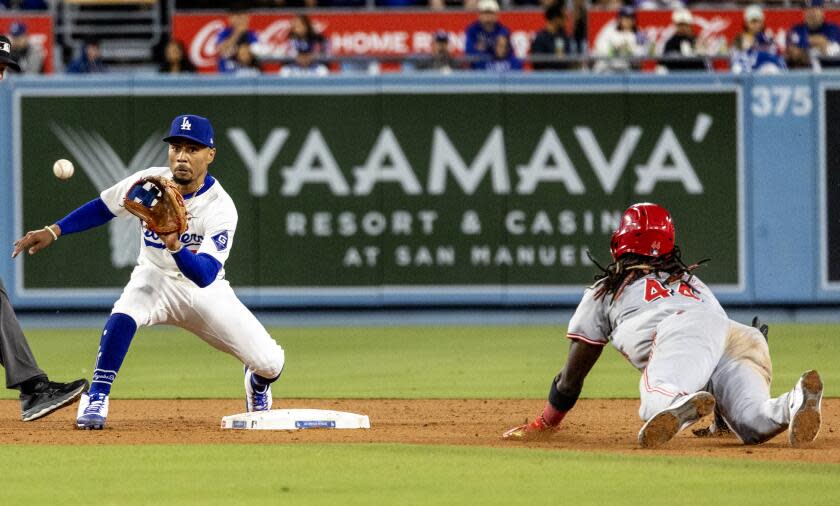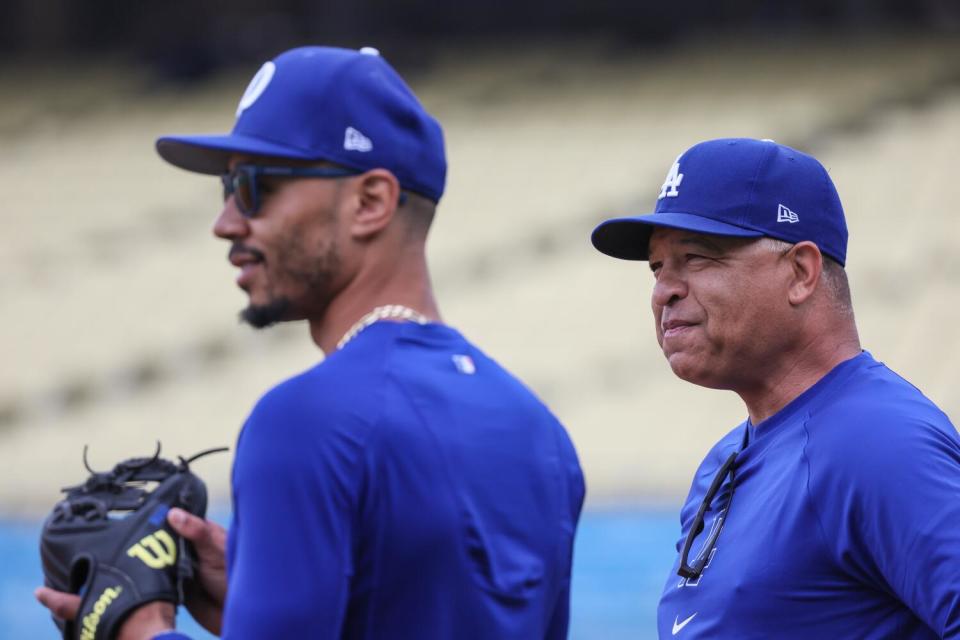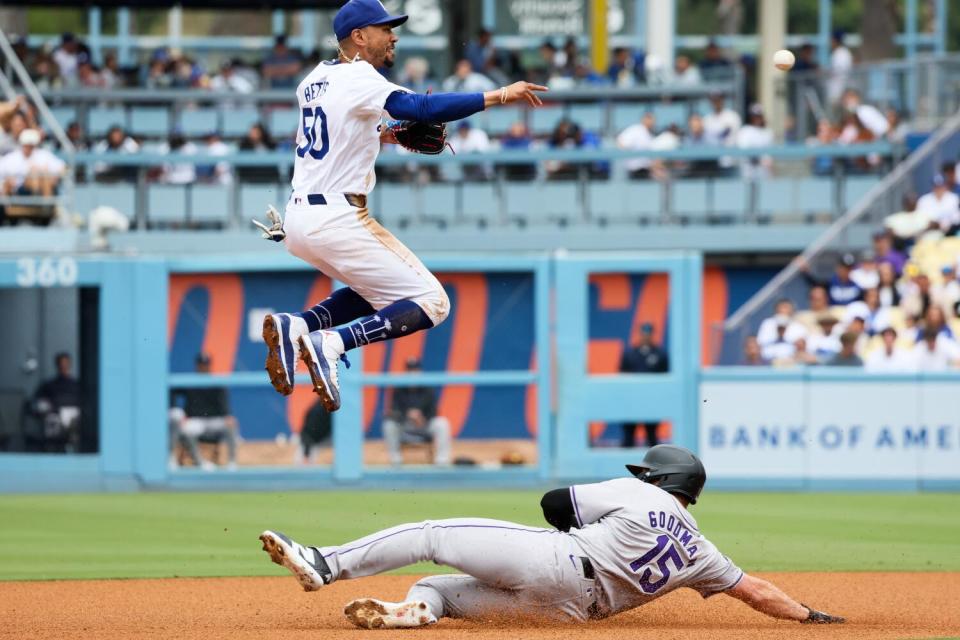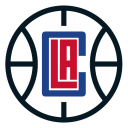'Uncharted territory': Is Mookie Betts at shortstop a sustainable solution for the Dodgers?

Three months in, the amazement has yet to dissipate.
Every day, the Dodgers watch Mookie Betts take the field hours before first pitch, field dozens of ground balls in pregame infield drills, and endure the toil of perfecting the shortstop position.
Every day, since the former Gold Glove right fielder made the unprecedented switch two weeks before the start of this season, the team marvels at the progress Betts has been able to so quickly make.
“There’s no perfect player,” Dodgers manager Dave Roberts said recently. “But if there is as close to a perfect player, it’s Mookie Betts. It really is.”
Indeed, in what was a virtually unprecedented defensive gamble this year, Betts’ move to shortstop hasn’t blown up in the Dodgers’ face.
Read more: Kiké Hernández trying to ‘stay level’ after slow start with Dodgers, live interview error
As the season nears the halfway mark, Betts has led the Dodgers to a 41-26 record entering Tuesday's game, providing a spark with his bat (he is hitting .309 with 10 home runs) and his glove (starting at shortstop in 55 of 67 games) to help the team surge to a 7½-game lead in the National League West.
Betts is far from a perfect shortstop. Playing the position regularly for the first time as a professional — and the first time at all since his days as a high school player growing up in Tennessee — there have been learning curves and growing pains, including a team-high nine errors and poor .957 fielding percentage (third-worst among 24 qualified MLB shortstops this season).
Such struggles, however, were inevitable for Betts this season. After replacing defensively scuffling teammate Gavin Lux at shortstop this spring, failure was the only way for Betts to learn a new, intricate, demanding position.
“I take a lot of pride in it, how I’ve come a long way,” Betts said this weekend, reflecting on the process while from a visiting locker at Yankee Stadium last weekend. “Starting from as low as I was, you go up pretty quick.”
What comes next, however, is much more unclear.
Between now and October — if not, more urgently, the July 30 trade deadline — the Dodgers will have to make several determinations regarding both Betts and their shortstop position:
Whether Betts can truly hone the role by the end of the year — and be trusted to play shortstop regularly in the playoffs.
Whether the process of getting there can be sustained without Betts overexerting himself physically, given the extensive pregame routine he has relied on for continued improvement.
And, whether keeping Betts at shortstop — or, potentially sliding him over to second base — makes the most sense in the long haul for this year’s Dodgers team.
Right now, “everything is on the table,” said one person with knowledge of the situation who wasn’t authorized to speak publicly.
Which is why, for as astonishing as Betts’ acclimation to shortstop has been, the process still feels stuck in an almost experimental phase — looming as one of the most important variables for a club with lofty World Series ambitions.
“I was talking to Lux,” Betts said after a recent game, “and I was like, ‘This is the hardest thing I've ever had to do.’ … Not looking for any sympathy. But, you know, it's tough. So I gotta get it done.”
During his first four years in the major leagues, Honus Wagner — or, as he is described on his Baseball Hall of Fame plaque, the “greatest shortstop of all time” — didn’t actually play a single game at the position.
Instead, after making 232 appearances in the outfield from 1897 to 1900, the Pittsburgh Pirates legend only started playing shortstop in 1901, and didn't move there permanently until 1904.
Over the following 120 years, no player is believed to have recorded more outfield appearances before switching to shortstop on a full-time basis. Few ever dared such an ambitious defensive change.
Read more: Dodgers showcase their World Series-caliber talent — and imperfections — vs. Yankees
That is, until this season came around.
Until Betts, the six-time Gold Glover who played a whopping 1,130 career games in the outfield before ever appearing at shortstop (five times more than Wagner did before making his switch), accepted the challenge with the Dodgers this spring, making a major career change at age 31.
“I’m doing something that is uncharted territory,” Betts said. “I can’t go ask someone. I can’t go talk to anybody. Nobody can lead me through this, because nobody has done this. So, it’s really like [being] a pioneer, trying to figure this whole thing out.”
Betts did have some familiarity with shortstop from his high school days. He was already preparing for a full-time switch to the infield this season, as well, set to become an everyday second baseman after playing there regularly in 2023.
Going straight to shortstop, though, was a monumentally taller task — like asking a teenager to take a driver’s test before they'd hardly even begun the learning permit phase.

Shortstop requires more range, more split-second instincts and a fundamental feel for making myriad types of throws across the diamond. There is less time to think, react or set your feet. And only through extensive practice — and obligatory failure — can the correct habits be developed.
“For me, it’s something I know I can do,” Betts said. “But I know that it’s gonna take time. There’s no way to go play shortstop — elite shortstop — in a month, with zero practice.”
Three months in, it remains a quixotic quest.
Dodgers officials, however, have been profuse in their praise of Betts since the start of the season.
“I don’t think it’s being talked about enough just how selfless Mookie is,” president of baseball operations Andrew Friedman said. “Most superstar players wouldn’t put themselves in the position of being as vulnerable as he is. And the way he has attacked it, the improvement we have seen day over day, week over week, it’s been astonishing.”
Teammates have lauded the tireless effort that has gone into his transition — most notably the extensive routine of infield drills Betts will take under the guidance of longtime third base coach Dino Ebel and experienced shortstop teammate Miguel Rojas before almost every game.
“Everything he does, he’s trying to be the best at it," first baseman Freddie Freeman said. "So, because he hasn’t done this before, he’s overloading the work. Trying to do everything he can to put himself, and us, in the best situation.”
Despite all that, publicly available defensive metrics paint a much bleaker picture of Betts’ shortstop performance.
Read more: 'I like to be in the spotlight.' Teoscar Hernández powers Dodgers to series win over Yankees
His nine errors so far are fourth-most at the position. His .957 fielding percentage is better than only Cincinnati’s Elly De La Cruz and Pittsburgh’s Oneil Cruz. He does rank 10th among qualified shortstops in “defensive runs saved,” and has helped turn 26 double plays, 12th-most among the group.
But, according to Baseball Savant's all-encompassing “outs above average” metric, Betts has been the worst overall shortstop in the majors.
And on multiple occasions in recent weeks, he has aired frustrations with himself about miscues in the field.
“I gotta clean up a lot of things,” Betts said after committing two errors in Pittsburgh last week. “There's no excuses. But the fact is, this is all new to me, man. This is all new. And it's going to take more than two months to get.”
The good news for the Dodgers is that Betts has looked increasingly smoother with his shortstop play. He is better at going to his right and fielding grounders on his backhand. After “cutting” his throws too much early in the year, as Freeman described it, with the ball tailing too low and to the left, Betts has gotten more consistent and accurate with his tosses of late.
“It’s Mookie Betts,” Freeman said. “Everyone knows he will master it.”
The question, however, is how long such mastery will take to achieve — and how well Betts will hold up physically in the meantime.
“You can plateau pretty quick,” Betts said of his progression of learning shortstop defensively. “So I don’t know where I’m at. I just know I’m trying to get better each day, and see what happens.”
Roberts called it a “lazy” narrative. But that doesn’t mean it contains no truth.
After winning NL player of the month in April, and emerging as an early most valuable player front-runner by mid-May, Betts’ offensive production has started to slide in recent weeks. Since May 16, he is batting just .226, with a pedestrian .381 slugging percentage over his last 21 games.
“It's not that good,” Betts said of his recent production. “But I'm grinding. I'm working. You know me. I'm always working to get better. It's just not happening.”
While any number of factors could be causing such struggles, one point of speculation has centered on Betts’ defensive workload — and whether all of his efforts to learn shortstop are hampering him in any way at the plate.
Read more: Motivated by move to shortstop, Dodgers veteran Mookie Betts is on a tear
Both Betts and Dodgers personnel scoffed at that theory last week.
Betts said that, thanks to changes in his diet and daily routine (even as simple as morning walks with his family, to keep his body moving), this year is actually “the best I've felt since I was probably 21 or 22 years old.”
Ebel, who directly oversees the Dodgers' infield defense, said the club’s training staff has offered similar evaluations, especially as Betts has started streamlining his daily regime of infield drills in recent weeks (where Betts once took five reps of each specific ground ball type, for example, he now takes only three).
“It’s a long season,” Ebel said. “But we’re watching him daily, and he says ‘I’ve never felt better.’”
Nonetheless, until Betts maintains dominance at the plate and in the field, there will be calls from some corners of the fanbase for the team to make a defensive lineup change.
The simplest solution could come internally. Rojas, who was the Dodgers’ primary shortstop last season, is not only among the most sure-handed players in the sport at the position, but is also having a resurgent season at the plate, batting .283 with 11 extra-base hits.
Right now, Rojas is playing mainly at second and third base — clearing the way for Betts to get as many reps as possible at shortstop, where the Dodgers hope he can continue his steady defensive improvements.

Rojas is also battling some leg soreness that has prevented him from playing on an everyday basis the past two weeks.
But, come the stretch run of the season, the Dodgers could always opt to reinsert Rojas as their primary shortstop and slide Betts over to second base (a return to right field, people around the organization believe, is unlikely at this stage of Betts’ season).
The trade deadline will offer other potential opportunities, too.
It’s worth remembering, the Dodgers have had past interest in Milwaukee shortstop Willy Adames (though he seems destined to stay with a surprise Brewers team currently leading the NL Central).
They could also be a fit for someone like Toronto star Bo Bichette, but only in the unlikely event that the Blue Jays opt for a midseason fire sale.
The rest of the trade market looks light on top shortstop targets, though smaller names, such as Paul DeJong of the Chicago White Sox, should be available.
All of this is to say: There will be more traditional shortstops than Betts, both inside the organization and not, for the Dodgers to consider before they reach October.
And if the team ultimately does go in a different direction, Betts said last weekend that he would understand.
“I don’t care,” he said. “I just want to win. If I’m not serviceable enough and they need to move off [playing me at shortstop], I ain’t got no pride when it comes to this. I just want to win. I genuinely don’t care about anything else.”
Read more: 'I believe in myself': Examining the challenges of Mookie Betts' move to shortstop
For now, though, the Dodgers don’t appear to be rushing down that path.
They remain mesmerized by all he has accomplished as a shortstop thus far. They’ve seen enough to not yet give up on the possibility of him cementing himself there for the rest of the season.
“No one wants to be uncomfortable and put in a position to fail, let alone a superstar,” Roberts said. “He could’ve stayed in right field and been a Hall of Famer. Or gone to second base and rode his ticket to the Hall of Fame. But now, he’s putting himself out there to play short.”
And he’s giving the club much to consider in the process.
Sign up for more Dodgers news with Dodgers Dugout. Delivered at the start of each series.
This story originally appeared in Los Angeles Times.

 Yahoo Sport
Yahoo Sport 




































































